The Legislative Branch
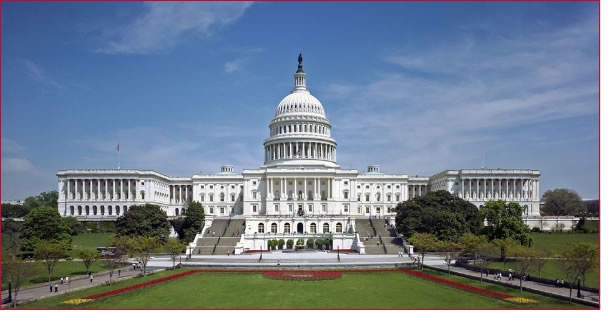
The image is a photo of the United States Capitol building, which is where Congress meets.
The Legislative Branch of government is outlined in Article I of the Constitution. It is often called the first branch of government. The Legislative Branch is given the responsibility of enacting public policy in a manner that represents the people.
In this lesson you will learn how Congress is organized. You will also explore constitutional provisions regarding Congress, and checks it has on the Executive and Judicial branches of government.
Congress is the lawmaking or legislative branch of our federal government. The Legislative Branch is made up of a bicameral Congress with two chambers: the Senate and House of Representatives. There are 535 voting members in Congress including 435 Representatives and 100 Senators. They meet at the Capital Building in Washington D.C. to make laws for our country.
Watch Legislative Branch (1:06) to learn more about the structure of the Senate and the House of Representatives. Click here to view the instructions for logging in to Discovery Education Streaming videos.
Representing "We the People"
Article I of the Constitution gives the Legislative Branch the power to make laws. Article I also states that "the People" will elect the members of Congress to reflect the will of the people.
Each member of Congress is elected by constituents, or people represented by a member of Congress, from his or her geographic area.
United States Constitution: The Preamble
Click here to view the instructions for logging in to Discovery Education Streaming videos.
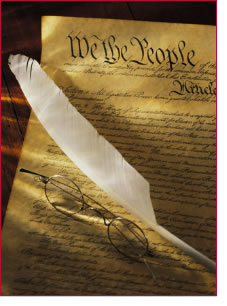
The image is a photo of the first page of the Constitution. The Preamble is at the top with the words,"We the People" written much larger than the other words.
Members of Congress must represent their constituents' interests and concerns while also representing what is best for the country as a whole. Occasionally, what is best for constituents and what is best for the nation as a whole may conflict. Members of Congress must balance them both to obtain an outcome that is best for all.
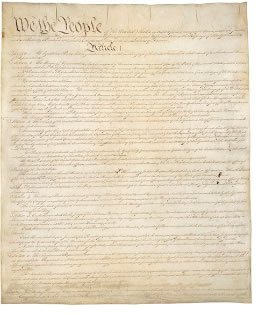
The image is one of the Constitution of the United States.
Powers of Congress
• Article I of the Constitution also outlines the powers given to Congress. Article I, Section 8 lists approximately 19 enumerated powers, or expressed powers that are specifically granted to Congress in the Constitution.
• Article 1, Section 8, Clause 18 contains the necessary and proper clause which states that Congress has the power to "make all Laws which shall be necessary and proper for carrying into executions the (expressed) Powers and all other Powers vested (given) by the Constitution." In other words, this clause gives Congress implied powers or suggested powers not specifically stated in the Constitution.
Read Article 1 Section 8 for a complete list of the enumerated powers.
Financial Powers
The Constitution gives Congress the expressed power to borrow money by levying/collecting taxes and borrowing money to run the government.
The inability to collect taxes was a major weakness of the Articles of Confederation; therefore, the framers of the Constitution specifically granted Congress the "power to lay and collect taxes. Tariffs provided a majority of tax revenues for much of our history. Indirect taxes like those placed on gasoline, liquor, or transportation services are included in the price of a product and are collected by the government. The Constitution limited direct taxes by Congress until the 16th Amendment, passed in 1913 giving Congress the power to collect a federal income tax.
In addition to the power to collect taxes, the Constitution gives Congress the expressed power of borrowing money to run the government.
The power to borrow money allows the government to continue to function even when there is a budget deficit or not enough money to cover expenses. Deficit spending is primarily intended for emergencies like times of war; however, it has become a standard practice by Congress.
Article I, Section 8, Clause 3 of the Constitution contains the commerce clause which grants Congress the power to regulate commerce between the states, with Indian tribes, and with foreign nations. In 1824, the Supreme Court helped to define the commerce clause in the landmark case Gibbons v. Ogden.

The image depicts the Capitol building with money flowing out of the top.
National Defense and Foreign Policy Powers
In addition to powers related to financial matters, the Constitution gives Congress powers related to national defense and foreign policy. The responsibility is actually divided between Congress and the President.
Congress is given the power to declare war. However, according to the War Powers Resolution of 1973, the President can send troops into battle without approval by Congress for up to 60 to 90 days. Article I, Section 8, Clauses 12 and 13 of the Constitution gives Congress the power to create an army and a navy and to provide for their funding. States share the power of maintaining a militia with Congress due to establishment of a National Guard within each state.
Watch Other Responsibilities (1:16) to learn more about these powers. Click here to view the instructions for logging in to Discovery Education Streaming videos.
Other Powers
The Constitution gives Congress many other powers, both expressed and implied. The following is a list of additional expressed powers and non-legislative powers given to Congress:
• Power to coin money and punish counterfeiters.
• Power to create a postal service.
• Power to establish standardized weights and measures.
• Power to write laws concerning copyright, patent laws, and bankruptcy.
• Power to establish a "uniform Rule of Naturalization", the process
through which an immigrant becomes a citizen.
• Power to establish federal courts below the Supreme Court.
• Power to make laws concerning elections of its members to Congress.
• Both Houses of Congress share the power to propose amendments to the
Constitution and to conduct investigations.
Checks and Balances
In addition to separating the powers of the government into three branches, a series of checks and balances were put into effect. This system allows each branch to limit the power of the other two branches.
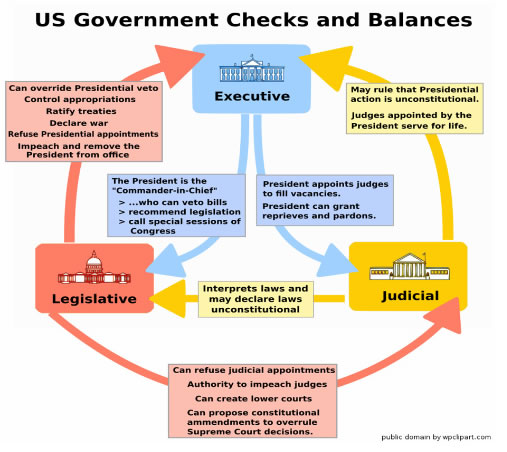
The image is a flow chart that reflects the system of checks and balances between the three branches of government.
Watch Checks and Balances (1:26) to learn more.
Click here to view the instructions for logging in to Discovery Education Streaming videos.
Checks on the Executive Branch
Congress may check the Executive Branch by using its "power of the purse" and "the power of advice and consent." Only Congress has the power to approve spending by the federal government, hence the phrase "power of the purse." Congress can refuse to provide funds to the President, or it may pass an appropriation act to fund only certain requests.
Congress also has the power of "advice and consent" concerning presidential appointments and treaties. The Senate can refuse to approve presidential appointees. Also, the President must also get a 2/3 vote of approval from the Senate in order for a treaty to become a law.

Secretary of State Condoleezza Rice testifies before the Senate Foreign Relations Committee in 2007 (Discovery Education).
Congress has other powers to check the Executive Branch including the power to override a veto and the power to impeach. Congress can override a Presidential veto with a two-thirds vote of each House of Congress. Congress also has the power of oversight, or the power to review the Executive Branch to make sure laws are being followed.
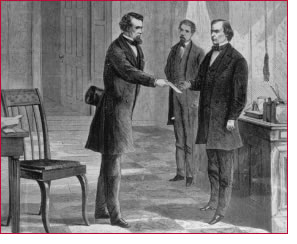
Summons served on President Andrew Johnson (IRC).
Congress also has the power of impeachment, or the power to charge officials in the Executive Branch with wrongdoing and bring them to trial. Andrew Johnson and Bill Clinton are the only two presidents to be impeached. Neither President was removed from office.
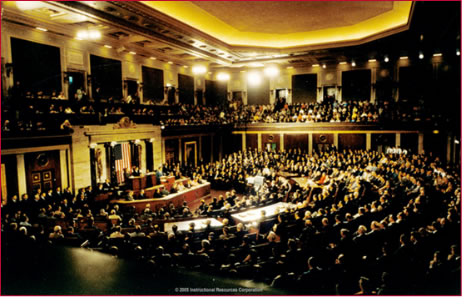
The image is one of the Senate Impeachment Trial of President Bill Clinton (IRC).
Checks on the Judicial Branch
The power of consent and impeachment also provides Congress with checks on the Judicial Branch. Congress can refuse to approve judicial appointments, and can impeach or bring charges against justices within the Judicial Branch. Finally, Congress can use its power to amend the Constitution as a check and balance on the power of the Supreme Court to declare laws unconstitutional.
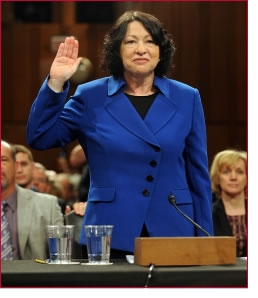
Supreme Court Justice nominee Sonia Sotomayor is sworn in (Discovery Education).
Representing "We the People"
The framers carefully crafted the legislative branch to be representatives of the people. From the vast lawmaking powers to the system of checks and balances over the executive and judicial branches, our Congress was created to be the best representative branch for "We the People."
Watch Conclusion and Review (1:38) to review the Legislative Branch.
Click here to view the instructions for logging in to Discovery Education Streaming videos.